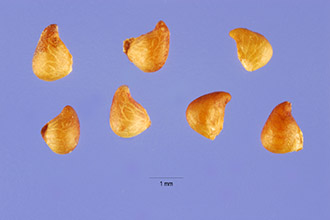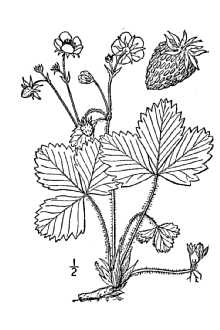Woodland Strawberry
Scientific Name: Fragaria vesca L.

| General Information | |
|---|---|
| Usda Symbol | FRVE |
| Group | Dicot |
| Life Cycle | Perennial |
| Growth Habits | Forb/herb |
| Native Locations | FRVE |
Plant Guide
Alternate Names
Woodland strawberry; California strawberry
Uses
Ethnobotanic: The fruit was gathered by native peoples throughout the United States and Canada. Such cultural groups include the Micmac, Huron, Potawatomi, Creek, Blackfoot, Iroquois, and many other groups. The fruit was eaten raw and not preserved by California Indian tribes including the Coast Yuki and the Karok. Furthermore, a tea was made from the leaves by the Upriver Halkomelem and Sechelt of British Columbia, the Cowlitz of Washington and the Micmac of the maritimes. Wildlife: The Portola woodrat and the valley quail eat the fruit and leaves of wild strawberries.
Status
Please consult the PLANTS Web site and your State Department of Natural Resources for this plant’s current status, such as, state noxious status and wetland indicator values.
Description
General: Rose Family (Rosaceae). This herbaceous perennial plant spreads by seed, short rhizomes and leafless stolons. The toothed leaves are thin and basal with a petiole generally 3-12 cm. They appear in leaflets of 3 and are sparsely hairy above. The flowers have 5 white petals with numerous pistils and 20-35 stamens. The five bractlets are often 2-lobed. The red fleshy fruit is covered with achenes. Carl Lindman ©Gerhard Keuck from Bilder ur Nordens @ Project Runeburg
Distribution
For current distribution, please consult the Plant Profile page for this species on the PLANTS Web site, It is found in northwestern California, the Cascade Ranges, the Sierra Nevada, central-western California, San Bernardino Mountains, Peninsular Ranges, to eastern North America, and south to Baja California and also Europe, , Use soil moisture sensors to measure the soil moisture of Woodland Strawberry.
Establishment
Adaptation: This plant is found below 2000 m in partial shade of closed-cone pine, evergreen, mixed conifer forests, and chaparral and has a very wide distribution. Planting: Dig up plantlets or runners and plant them in pots in summer, make sure to cover the stems and roots in soil. Place the pots in a hothouse to establish good, strong roots. Water the plants or runners and keep them moist. Plant the seedlings outdoors in the ground in the fall or winter after the rains have started. They should be planted in full sun in a light, loose soil, about ten inches apart. It will not take long for the plants to make a complete ground cover. Lightly fertilize the plants during the growing season. Note that those plants that have bigger flowers usually have less fruit while those with smaller flowers have more fruit. Protect the plants from gophers, deer, squirrels, raccoons, and other wildlife.
Management
Keep the runners pruned back because they can be invasive. It is necessary to divide the patch every 3 to 4 years and start a new patch for increased vigor. Younger plants are more vigorous and produce more berries. Cultivars, Improved and Selected Materials (and area of origin) FRVE is somewhat available through native plant nurseries within its range. Contact your local Natural Resources Conservation Service (formerly Soil Conservation Service) office for more information. Look in the phone book under ”United States Government.” The Natural Resources
Conservation
Service will be listed under the subheading “Department of Agriculture.”

